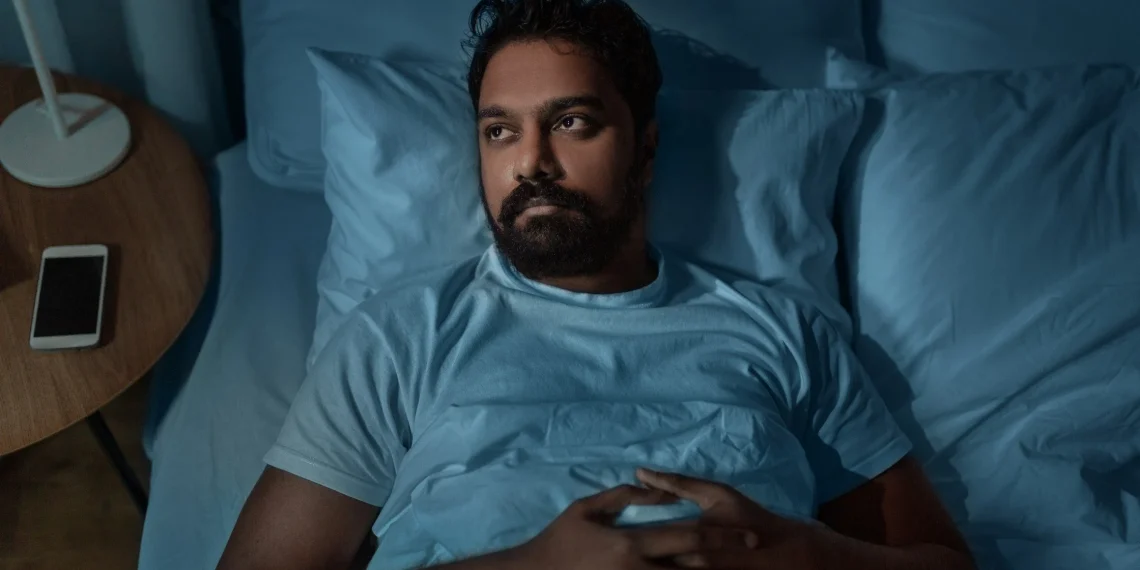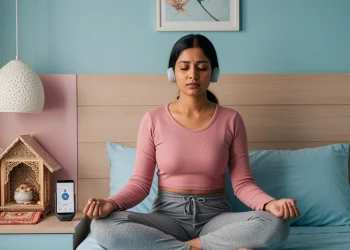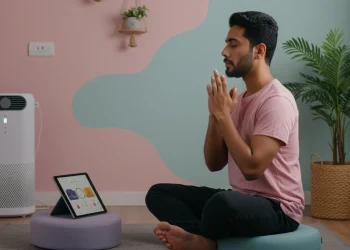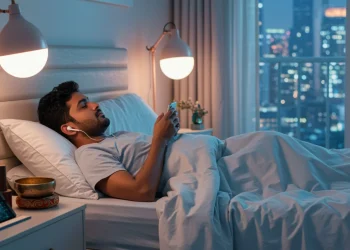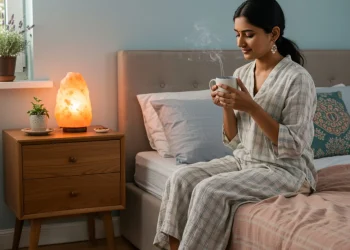Understanding, recognizing, and addressing the sleep challenges affecting millions of Indians
The Hidden Sleep Disorder Epidemic in India
Sleep disorders remain one of India’s most overlooked health crises. Behind the bustling streets and thriving economy lies a troubling reality: millions of Indians struggle with undiagnosed and untreated sleep conditions that silently impact their daily lives, relationships, and long-term health.
Recent comprehensive studies reveal startling statistics that demand immediate attention. 25.7% of the Indian population suffers from insomnia, while an alarming 37.4% experience obstructive sleep apnea (OSA). These numbers translate to over 350 million Indians dealing with significant sleep disruptions every single night.
The scope extends far beyond these primary conditions. Sleep paralysis affects approximately 8-15% of Indians, with urban populations showing higher prevalence rates. Restless leg syndrome impacts 7-10% of adults, while narcolepsy, though less common, affects thousands who often go years without proper diagnosis.
The Urban Sleep Crisis
India’s rapid urbanization has created unique sleep challenges. Metropolitan cities like Mumbai, Delhi, Bangalore, and Kolkata report the highest rates of sleep disorders. The combination of longer commutes, extended work hours, digital device exposure, and environmental factors creates a perfect storm for sleep disruption.
Working professionals in Tier 1 cities average 6.2 hours of sleep per night, significantly below the recommended 7-9 hours. This chronic sleep deprivation doesn’t just cause daytime fatigue – it increases the risk of developing serious sleep disorders by up to 40%.
Cultural Barriers to Recognition
Traditional Indian society often views sleep problems through a different lens. Many families dismiss sleep difficulties as temporary stress or attribute them to spiritual causes. This cultural interpretation, while sometimes helpful, can delay crucial medical intervention.
The concept of “adjusting to circumstances” deeply ingrained in Indian culture sometimes prevents individuals from seeking help for sleep issues. Family members may encourage tolerance rather than treatment, viewing sleep problems as a weakness rather than a legitimate health concern.
Breaking the Silence Around Sleep Health
The stigma surrounding sleep disorders in India creates additional barriers to treatment. Mental health awareness campaigns have made progress, but sleep health remains in the shadows. Many Indians fear that admitting to sleep problems might affect their career prospects or marriage proposals.
Professional environments often celebrate those who “sacrifice sleep for success,” inadvertently promoting unhealthy sleep habits. This cultural narrative needs transformation. Quality sleep isn’t a luxury – it’s essential for optimal performance, creativity, and long-term health.
The Economic Impact
Untreated sleep disorders cost the Indian economy an estimated ₹1.3 trillion annually in lost productivity, healthcare expenses, and workplace accidents. Individual families face mounting medical bills for conditions that could be prevented with proper sleep disorder management.
The ripple effects extend beyond economics. Sleep-deprived individuals show 23% higher rates of relationship conflicts, 31% increased risk of workplace accidents, and 45% more likelihood of developing anxiety or depression.
Understanding sleep disorders isn’t just about individual health – it’s about strengthening families, communities, and the nation’s overall well-being. Recognition and early intervention can transform not just sleep quality, but entire life trajectories.
Insomnia: The Most Common Sleep Thief
Insomnia stands as India’s most prevalent sleep disorder, affecting one in four adults. Unlike occasional sleepless nights before important events, clinical insomnia involves persistent difficulty falling asleep, staying asleep, or achieving restorative sleep for at least three months.
Understanding Insomnia Types in Indian Context
Acute Insomnia typically lasts less than three months and often connects to specific stressors. In India, common triggers include job changes, family conflicts, academic pressure, or financial concerns. This type usually resolves once the stressor diminishes.
Chronic Insomnia persists for three months or longer and requires professional intervention. Indian urban populations show particularly high rates of chronic insomnia, with 32% of IT professionals experiencing persistent sleep difficulties.
Sleep Maintenance Insomnia involves frequent nighttime awakenings. This type particularly affects Indian women aged 35-50, often coinciding with hormonal changes and increased family responsibilities.
The Urban Professional’s Dilemma
Indian cities never truly sleep, and neither do many of their residents. The typical day for an urban professional begins at 6 AM and extends well past 10 PM when accounting for commute times. This schedule leaves minimal time for proper sleep preparation.
Technology compounds the problem. 68% of Indian professionals report using smartphones within 30 minutes of bedtime. The blue light emission disrupts natural melatonin production, making sleep initiation significantly more difficult.
Work-related stress manifests differently across Indian industries. IT professionals report racing thoughts about project deadlines. Healthcare workers experience shift-related sleep disruption. Financial sector employees struggle with market-related anxiety affecting sleep quality.
Family Dynamics and Sleep Disruption
Traditional Indian family structures can inadvertently contribute to insomnia. Joint family systems, while providing emotional support, sometimes compromise individual sleep needs. Noise from family activities, shared sleeping spaces, and varying bedtime schedules create challenges.
Caring for elderly parents or young children often interrupts sleep patterns. Many Indian women report chronic sleep disruption due to nighttime caregiving responsibilities. This pattern can persist long after children grow up or elderly parents no longer need nighttime care.
The cultural expectation to prioritize family needs over personal health sometimes prevents individuals from addressing their sleep problems. Creating boundaries around sleep time requires delicate navigation of family dynamics and cultural expectations.
Evidence-Based Treatment Approaches
Cognitive Behavioral Therapy for Insomnia (CBT-I) shows remarkable success rates, with 70-80% of patients experiencing significant improvement within 6-8 weeks. This approach addresses both thoughts and behaviors that interfere with sleep.
CBT-I techniques particularly effective for Indians include:
- Sleep Restriction Therapy: Limiting time in bed to actual sleep time, gradually increasing as sleep efficiency improves
- Stimulus Control: Using the bedroom only for sleep and intimacy, removing work materials and electronic devices
- Relaxation Training: Incorporating meditation techniques familiar to Indian culture, such as deep breathing and progressive muscle relaxation
Sleep Hygiene Education provides the foundation for long-term success. This includes maintaining consistent sleep-wake times even on weekends, creating a cool, dark, quiet sleep environment, and avoiding caffeine after 2 PM.
When Lifestyle Changes Aren’t Enough
Some individuals require additional interventions beyond behavioral therapy. Sleep aids should be used cautiously and under medical supervision, as they can create dependency and may not address underlying causes.
Natural alternatives show promise for many Indians. Ashwagandha, traditionally used in Ayurveda, demonstrates sleep-improving properties in clinical studies. Melatonin supplements can help reset disrupted circadian rhythms, particularly beneficial for shift workers.
Underlying medical conditions sometimes contribute to insomnia. Thyroid disorders, diabetes, and hypertension – all prevalent in India – can significantly impact sleep quality. Treating these conditions often improves sleep naturally.
Mental health considerations cannot be ignored. Anxiety and depression accompany insomnia in 60% of cases. Integrated treatment addressing both mental health and sleep typically produces better outcomes than treating either condition alone.
Professional help becomes essential when insomnia persists despite lifestyle modifications, impacts daily functioning, or includes concerning symptoms like mood changes or memory problems. Sleep medicine specialists in major Indian cities now offer comprehensive evaluation and treatment options.
Sleep Paralysis: Understanding the Frightening Experience
Sleep paralysis represents one of the most misunderstood sleep phenomena, particularly in Indian cultural contexts where supernatural explanations often overshadow scientific understanding. This temporary inability to move or speak while falling asleep or waking up affects millions of Indians, yet many suffer in silence due to fear and cultural stigma.
The Science Behind the Experience
During sleep paralysis, the brain awakens while the body remains in REM sleep’s natural muscle paralysis state. This disconnect creates the terrifying sensation of consciousness without physical control. Episodes typically last 30 seconds to several minutes, though they feel much longer to those experiencing them.
The condition affects 8-15% of Indians, with urban populations showing higher prevalence rates. Stress, irregular sleep schedules, and sleep deprivation – all common in modern Indian lifestyles – significantly increase susceptibility to sleep paralysis episodes.
Cultural Interpretations vs. Scientific Reality
Traditional Indian culture often attributes sleep paralysis to supernatural causes. Terms like “pinni” in Hindi or “ghost pressing on chest” reflect cultural attempts to explain this frightening experience. While these interpretations provide cultural context, they can prevent individuals from seeking appropriate medical help.
Many Indians describe feeling a malevolent presence during episodes, often interpreting this as spiritual attack or curse. The scientific explanation involves the brain’s fear centers activating while the body cannot respond, creating intense anxiety and hallucinatory experiences.
Family elders might recommend religious remedies or protective charms. While these approaches can provide psychological comfort, they shouldn’t replace understanding the medical nature of sleep paralysis or prevent seeking professional help when episodes become frequent.
Recognizing Triggers and Patterns
Stress and Anxiety: Academic pressure, job insecurity, family conflicts, and financial worries significantly increase sleep paralysis frequency among Indians.
Sleep Deprivation: Working professionals averaging less than 6 hours nightly show 300% higher rates of sleep paralysis compared to those getting adequate rest.
Irregular Sleep Schedules: Shift workers, students with erratic study patterns, and frequent travelers experience more episodes due to disrupted circadian rhythms.
Sleep Position: Sleeping on the back increases sleep paralysis likelihood, though many Indians aren’t aware of this connection.
Substance Use: Alcohol, caffeine late in the day, and certain medications can trigger episodes in susceptible individuals.
Immediate Coping Strategies During Episodes
Understanding what to do during an episode can reduce fear and help regain control faster:
Focus on Small Movements: Instead of trying to move your entire body, concentrate on wiggling fingers or toes. These smaller movements often break through the paralysis first.
Control Your Breathing: Deep, slow breathing helps calm panic and may help end the episode sooner. Focus on exhaling slowly through pursed lips.
Stay Calm: Remember that sleep paralysis, while frightening, is harmless. Remind yourself that the experience will end soon and you’re not in any physical danger.
Avoid Fighting: Struggling against the paralysis often intensifies fear and prolongs the episode. Acceptance and patience typically lead to faster resolution.
Prevention Through Sleep Hygiene
Consistent sleep hygiene significantly reduces sleep paralysis frequency:
Regular Sleep Schedule: Going to bed and waking up at the same time daily, even on weekends, helps stabilize the sleep-wake cycle.
Adequate Sleep Duration: Most adults need 7-9 hours nightly. Prioritizing sufficient sleep dramatically reduces episode frequency.
Stress Management: Regular meditation, yoga, or other stress-reduction techniques help prevent the anxiety that often triggers sleep paralysis.
Comfortable Sleep Environment: Cool, dark, quiet rooms promote better sleep quality and reduce disruptions that might trigger episodes.
Avoiding Triggers: Limiting caffeine after 2 PM, avoiding large meals before bedtime, and reducing alcohol consumption all help prevent episodes.
When to Seek Professional Help
While occasional sleep paralysis episodes are generally harmless, frequent occurrences warrant medical evaluation. Seek professional help if you experience:
- Episodes more than once monthly
- Significant daytime fatigue or sleepiness
- Fear of sleeping due to paralysis episodes
- Impact on work, relationships, or daily activities
- Accompanying symptoms like hallucinations or mood changes
Sleep specialists in India now better understand sleep paralysis and can provide effective treatment strategies. Don’t let cultural stigma prevent you from seeking help for a very treatable condition.
Sleep Apnea: The Silent Health Threat
Sleep apnea represents one of India’s most dangerous yet underdiagnosed sleep disorders. This condition involves repeated breathing interruptions during sleep, with each episode lasting 10 seconds or longer. The prevalence among Indian adults is staggering, yet most cases remain undiagnosed due to lack of awareness and limited screening.
Understanding the Types
Obstructive Sleep Apnea (OSA) accounts for 85% of cases and occurs when throat muscles relax excessively during sleep, blocking the airway. This type particularly affects Indians due to specific anatomical and lifestyle factors.
Central Sleep Apnea involves the brain failing to send proper signals to breathing muscles. While less common, it often accompanies heart conditions or occurs at high altitudes – relevant for those living in hill stations or traveling frequently to mountainous regions.
Mixed Sleep Apnea combines both obstructive and central components, typically beginning as obstructive sleep apnea and developing central characteristics over time.
Risk Factors Specific to Indian Population
Anatomical Predisposition: Indians often have smaller airways and different facial bone structures that increase OSA risk. Studies show Indians develop sleep apnea at lower BMI levels compared to Western populations.
Diabetes Prevalence: India’s diabetes epidemic significantly contributes to sleep apnea rates. Diabetics have 300% higher risk of developing OSA, and sleep apnea worsens blood sugar control, creating a dangerous cycle.
Dietary Factors: Traditional Indian diets high in refined carbohydrates and the increasing prevalence of processed foods contribute to weight gain and inflammation that worsen sleep apnea.
Air Pollution: Major Indian cities have air quality indices that reach hazardous levels. Chronic exposure to pollution causes upper airway inflammation, increasing sleep apnea severity.
Lifestyle Changes: Urbanization has led to more sedentary lifestyles, increased alcohol consumption, and altered eating patterns – all risk factors for developing sleep apnea.
Symptoms Often Dismissed as Normal
Many Indians and their families normalize sleep apnea symptoms, attributing them to stress, aging, or lifestyle factors:
Loud Snoring: Often viewed as annoying but harmless, loud snoring with gasping or choking sounds indicates serious breathing disruption requiring evaluation.
Daytime Fatigue: Persistent tiredness despite adequate sleep time gets attributed to work stress rather than potential sleep disorders.
Morning Headaches: Regular morning headaches result from oxygen deprivation during sleep but are often dismissed or treated with pain relievers.
Mood Changes: Irritability, depression, or anxiety stemming from poor sleep quality may be attributed to life circumstances rather than sleep disorders.
Cognitive Issues: Difficulty concentrating, memory problems, or decreased work performance often get blamed on aging or stress rather than sleep fragmentation.
Health Consequences and Comorbidities
Untreated sleep apnea creates cascading health problems particularly concerning for Indians already at higher risk for certain conditions:
Cardiovascular Disease: Sleep apnea increases heart disease risk by 230%. The repeated oxygen drops strain the cardiovascular system, leading to high blood pressure, irregular heart rhythms, and increased heart attack risk.
Diabetes Complications: Sleep apnea worsens insulin resistance and makes diabetes management more difficult. The sleep fragmentation disrupts hormones regulating blood sugar.
Stroke Risk: Indians with untreated sleep apnea face 400% higher stroke risk. The combination of high blood pressure and disrupted blood flow creates dangerous conditions.
Weight Gain: Sleep apnea disrupts hormones controlling hunger and satiety, making weight loss more difficult and creating a cycle where weight gain worsens sleep apnea.
Mental Health Impact: Chronic sleep disruption increases anxiety and depression rates significantly. The combination of poor sleep and health concerns creates substantial psychological burden.
Treatment Options Available in India
Continuous Positive Airway Pressure (CPAP): The gold standard treatment delivers pressurized air through a mask, keeping airways open during sleep. Modern CPAP machines are quieter and more comfortable than earlier versions.
Indian healthcare systems increasingly provide CPAP therapy, with options ranging from basic models to advanced machines with smartphone connectivity and automatic pressure adjustments.
Oral Appliances: Custom-fitted devices that reposition the jaw or tongue to keep airways open work well for mild to moderate cases. Several Indian cities now have dentists trained in sleep appliance therapy.
Surgical Options: Procedures to remove excess tissue, reposition jaw structures, or implant devices that stimulate airway muscles are available in major Indian medical centers.
Lifestyle Modifications: Weight loss, positional therapy (avoiding back sleeping), alcohol reduction, and smoking cessation significantly improve mild to moderate sleep apnea.
Traditional Approaches: Certain yoga breathing exercises and pranayama techniques may help strengthen airway muscles, though these should complement rather than replace medical treatment for moderate to severe cases.
Early diagnosis and treatment of sleep apnea can prevent serious health complications and dramatically improve quality of life. If you or family members exhibit symptoms, seeking evaluation from sleep specialists or pulmonologists could be life-saving.
Lesser-Known Sleep Disorders
Beyond the commonly discussed sleep problems lie several conditions that significantly impact Indians’ sleep quality and daily functioning. These disorders often go unrecognized for years, with symptoms attributed to stress, aging, or other factors.
Restless Leg Syndrome in Indian Context
Restless Leg Syndrome (RLS) affects approximately 7-10% of Indian adults, causing uncomfortable sensations in the legs and an irresistible urge to move them, particularly during evening hours and sleep attempts.
The condition manifests differently across Indian populations. Urban professionals often experience symptoms during long commutes or extended sitting periods. The crawling, tingling, or burning sensations typically worsen with rest and improve with movement.
Dietary factors play a significant role in Indian populations. Iron deficiency, common among Indian women due to dietary patterns and menstrual factors, strongly correlates with RLS severity. Traditional vegetarian diets, while healthy, sometimes lack easily absorbed iron sources.
Cultural barriers to diagnosis include dismissing leg discomfort as normal aging or attributing symptoms to spiritual causes. Family members might suggest traditional remedies like oil massage, which can provide temporary relief but don’t address underlying causes.
Treatment approaches include iron supplementation when deficiency exists, avoiding caffeine and alcohol, and establishing regular exercise routines. Severe cases may require medication, but lifestyle modifications often provide significant improvement.
Narcolepsy Awareness and Support
Narcolepsy affects thousands of Indians but remains severely underdiagnosed. This neurological condition involves the brain’s inability to properly regulate sleep-wake cycles, leading to excessive daytime sleepiness and sudden sleep attacks.
Symptoms often misunderstood in Indian contexts include sudden muscle weakness triggered by emotions (cataplexy), sleep paralysis, and vivid hallucinations when falling asleep or waking up. These symptoms frequently get attributed to stress, spiritual experiences, or character weakness.
Educational institutions sometimes view narcoleptic students as lazy or unmotivated rather than recognizing a legitimate medical condition. This misunderstanding can derail academic and career prospects without proper diagnosis and accommodation.
Social stigma surrounding narcolepsy can be particularly intense in Indian society, where falling asleep inappropriately might be viewed as disrespectful or unprofessional. Building awareness among families and employers is crucial for creating supportive environments.
Treatment involves stimulant medications to maintain wakefulness, scheduled naps, and lifestyle modifications. Support groups, though limited in India, provide valuable connections with others facing similar challenges.
Circadian Rhythm Disorders from Shift Work
India’s 24/7 economy means millions work non-traditional hours, leading to widespread circadian rhythm disruption. Call centers, healthcare facilities, manufacturing plants, and security services employ workers whose schedules conflict with natural sleep-wake cycles.
Shift Work Sleep Disorder affects 15-20% of night shift workers in India, causing insomnia during intended sleep times and excessive sleepiness during work hours. The condition goes beyond normal adjustment difficulties to persistent sleep disruption even after months in shift work.
Rotating shifts create additional challenges. The body struggles to adapt when schedules change weekly or monthly. Fixed night shifts actually produce better sleep adaptation than constantly changing schedules.
Light exposure therapy helps reset circadian rhythms. Bright light during night shifts and darkness during daytime sleep improves adaptation. However, most Indian workplaces lack appropriate lighting systems for shift worker health.
Melatonin supplementation can help reset circadian rhythms when timed correctly. Taking melatonin 30 minutes before intended sleep time helps signal the body to prepare for rest.
Family education is crucial. Households need to understand that shift workers require protected sleep time and environmental modifications to support daytime sleeping.
Sleep-Related Movement Disorders
Several movement disorders specifically disrupt sleep, often affecting bed partners as well as the individual:
Periodic Limb Movement Disorder involves repetitive leg movements during sleep that cause frequent awakenings. Many Indians remain unaware they’re experiencing these movements unless partners report them.
Sleep-Related Leg Cramps affect up to 30% of Indians over 50, causing painful muscle contractions that interrupt sleep. Dehydration, electrolyte imbalances, and certain medications increase susceptibility.
REM Sleep Behavior Disorder involves acting out dreams during REM sleep, potentially causing injury. This condition more commonly affects older men and may indicate underlying neurological changes.
Rhythmic Movement Disorder includes head banging or body rocking during sleep transitions. While more common in children, some adults continue these behaviors, often feeling embarrassed to discuss them with healthcare providers.
Recognition and treatment of these disorders significantly improve sleep quality and safety. Many respond well to lifestyle modifications, while others require specific medications or interventions.
Cultural and Traditional Approaches
India’s rich healing traditions offer valuable perspectives on sleep health that can complement modern medical treatments. Understanding how traditional approaches can work alongside contemporary medicine creates more comprehensive and culturally sensitive treatment strategies.
How Ayurvedic Treatments Complement Modern Medicine
Ayurveda views sleep disorders through the lens of dosha imbalances, offering treatments that address root causes rather than just symptoms. This holistic approach aligns well with modern sleep medicine’s emphasis on treating underlying factors.
Vata imbalance typically correlates with anxiety-related insomnia and racing thoughts at bedtime. Ayurvedic recommendations include warm oil massage (abhyanga), calming herbs like brahmi and jatamansi, and establishing regular routines to ground the nervous system.
Pitta imbalance manifests as difficulty falling asleep due to mental activity, awakening around 2-3 AM, and sleep disrupted by anger or frustration. Cooling practices, bitter herbs, and avoiding stimulating activities before bed help restore balance.
Kapha imbalance creates excessive sleepiness, difficulty waking, and feeling unrefreshed despite adequate sleep duration. Stimulating practices, lighter dinners, and energizing herbs support healthier sleep patterns.
Modern research validates several Ayurvedic approaches. Ashwagandha demonstrates significant sleep improvement in clinical trials. Meditation and pranayama breathing techniques show measurable benefits for sleep quality and disorder management.
Family Involvement in Treatment Success
Traditional Indian culture emphasizes family support in health matters. This collective approach can significantly enhance sleep disorder treatment outcomes when properly channeled.
Creating supportive environments involves educating entire families about sleep disorders and necessary accommodations. When families understand that sleep problems are medical conditions rather than personal failings, they provide better support.
Shared lifestyle modifications work particularly well in Indian contexts. When entire families adopt better sleep hygiene practices, individuals find it easier to maintain healthy sleep habits.
Caregiver education helps family members recognize symptoms and understand treatment importance. Spouses learning about sleep apnea symptoms can encourage proper CPAP use. Parents understanding teenage sleep needs can adjust household schedules accordingly.
Addressing Cultural Barriers to Seeking Help
Several cultural factors can delay or prevent appropriate treatment for sleep disorders:
Stigma reduction requires community education about sleep disorders as legitimate medical conditions. Healthcare providers and community leaders play crucial roles in changing perceptions.
Economic concerns about treatment costs need addressing through education about long-term health and financial consequences of untreated sleep disorders.
Gender-specific barriers affect women who may prioritize family needs over personal health. Creating women-friendly healthcare environments and flexible treatment schedules helps overcome these obstacles.
Religious considerations sometimes conflict with treatment recommendations. Working with religious leaders to explain how proper sleep supports spiritual practices and overall health can resolve these conflicts.
Integration of traditional wisdom with modern medicine creates treatment approaches that honor cultural values while providing effective medical care. This combination often produces better compliance and outcomes than purely Western medical approaches.
Building a Support System
Managing sleep disorders effectively requires more than individual effort – it demands a comprehensive support network that includes healthcare providers, family members, and community resources. Building this network takes time and effort but significantly improves treatment outcomes and quality of life.
Healthcare Provider Network in India
Primary Care Physicians serve as the first point of contact for most sleep concerns. Many Indian doctors now receive basic sleep medicine training, enabling them to identify common disorders and make appropriate referrals.
Sleep Specialists are increasingly available in major Indian cities. Pulmonologists, neurologists, and psychiatrists with sleep medicine training provide comprehensive evaluation and treatment for complex cases.
Sleep Centers offer overnight testing (polysomnography) to diagnose conditions like sleep apnea and periodic limb movement disorder. Major hospitals in Delhi, Mumbai, Bangalore, and Chennai now have accredited sleep laboratories.
Online Communities and Resources
Digital platforms provide valuable support for those dealing with sleep disorders:
Social Media Groups connect individuals facing similar challenges. Facebook groups for sleep apnea patients, insomnia support, and general sleep health provide peer support and practical tips.
Telemedicine Options expand access to sleep specialists, particularly beneficial for those in smaller cities or rural areas. Video consultations allow expert guidance without travel requirements.
Mobile Apps help track sleep patterns, provide relaxation techniques, and remind users about medication schedules. Indian-developed apps increasingly incorporate cultural preferences and local languages.
Family Education and Involvement
Understanding the Condition helps family members provide appropriate support rather than inadvertently hindering treatment. Educational materials in local languages make complex medical information more accessible.
Creating Supportive Environments involves entire households making adjustments to support better sleep. This might include noise reduction, schedule modifications, or dietary changes.
Encouraging Treatment Compliance becomes easier when families understand treatment importance and help with practical aspects like equipment maintenance or appointment scheduling.
Building an effective support system takes time but transforms the experience of managing sleep disorders from isolated struggle to shared journey toward better health. With proper support, most people with sleep disorders can achieve significant improvement in their sleep quality and overall well-being.
The path to better sleep begins with recognition that sleep disorders are real, treatable medical conditions. Whether you’re dealing with insomnia, sleep apnea, or any other sleep-related challenge, help is available. Start by consulting healthcare providers, educating your family, and connecting with others who understand your experience.
Quality sleep isn’t a luxury – it’s essential for health, happiness, and success. Take the first step toward reclaiming your nights and transforming your days by addressing sleep disorders with the seriousness and urgency they deserve.
If you’re experiencing symptoms of any sleep disorder mentioned in this guide, consult with a healthcare provider for proper evaluation and treatment. Early intervention leads to better outcomes and prevents complications.
Remember: Good sleep is the foundation of good health. Invest in your sleep health today for a healthier, more vibrant tomorrow.
